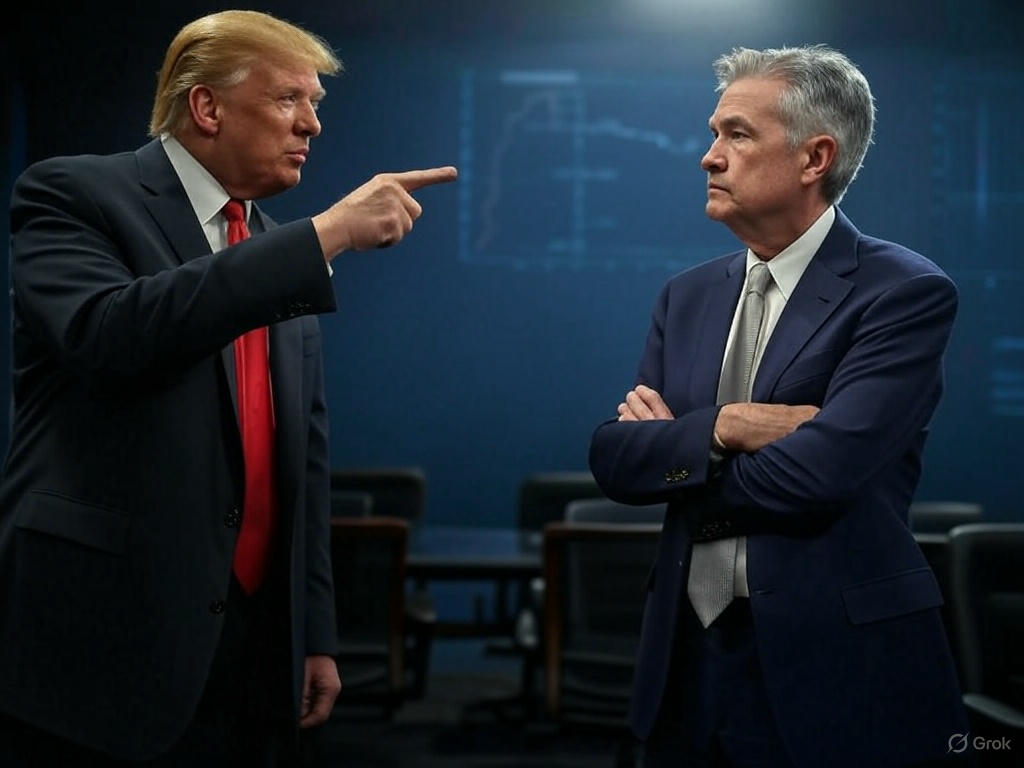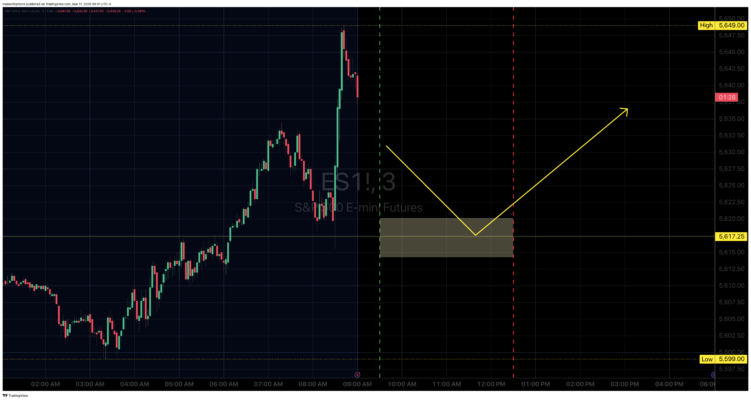Prioritizing Precision Entries and Managing Sector Rotations
• Missed early opportunities in energy stocks, where the team hesitated despite confirmation of breakout setups.
• Refinements to the ‘big ass fly’ strategy, emphasizing tighter entry zones and faster profit-taking in high-volatility conditions.
• Increased focus on volume confirmation, requiring alignment with price action to validate trade entries more effectively.
• Discussion on dynamic stop-loss placement, adapting stops in real time based on volatility rather than fixed point systems.
• Shift in sector allocation, moving away from underperforming financials and targeting momentum plays in healthcare and tech.
• Commitment to avoiding overtrading, particularly during midday chop, reinforcing patience until clearer setups form.
Summary
the team analyzed missed opportunities in energy sector breakouts, emphasizing the need to act quickly when setups meet predefined criteria. Ernie stressed refining the ‘big ass fly’ strategy by focusing on tighter entry zones and speeding up profit-taking in high-volatility situations.
The session covered increasing the emphasis on volume confirmation, ensuring that price movement aligns with volume spikes before taking trades. Dynamic stop-loss placement was also discussed, with a shift away from static stops toward real-time adjustments based on current volatility.
Sector rotation analysis led to the decision to move capital away from underperforming financial stocks and focus more on healthcare and tech momentum plays. Ernie concluded by reinforcing discipline, encouraging the team to avoid overtrading during less active periods and only engage when setups offer clear potential.
Tightening Execution and Reinforcing Sector Focus
• Consistent hesitation on early-session breakouts, particularly in the tech sector, resulting in missed entries despite clear signals.
• Refinement of stop-loss strategies, implementing ATR-based dynamic stops to better manage risk during increased volatility.
• Review of profit-taking discipline, with several trades closed prematurely, cutting short potential gains on confirmed trends.
• Shift in focus toward small-cap healthcare stocks, after mid-week data showed increased institutional buying and volume surges.
• Emphasis on avoiding overtrading during midday sessions, where choppy price action led to a lower win rate and increased risk exposure.
• Commitment to pre-market preparation, ensuring readiness for fast-moving opportunities and reducing hesitation at open.
Summary
the team reviewed execution across the previous week, focusing on consistent hesitation during early-session breakouts, particularly within tech names. Ernie stressed the importance of pre-market preparation and being ready to act decisively when trade signals align.
Refinements were made to the team’s stop-loss strategy, moving to ATR-based dynamic stops to better accommodate market volatility and reduce unnecessary stop-outs. There was also a review of profit-taking, with an acknowledgment that some trades were closed too early, sacrificing additional upside on solid trends.
The team shifted sector focus toward small-cap healthcare stocks, following data showing increased institutional participation and volume spikes. Ernie emphasized the need to avoid overtrading during midday chop and reinforced the value of maintaining patience until high-probability setups emerge.
The session concluded with a renewed commitment to structured pre-market routines, ensuring the team is ready to capitalize on key opportunities without hesitation.
In the precise game of 0DTE OTM Butterfly trading, your edge depends entirely on clarity and situational awareness. Your asymmetric strategy—built on a disciplined 10% debit rule—is robust enough to handle minor losses without sweat. But precision execution separates profitable traders from those left wondering where their big win disappeared.
With quarterly futures expirations like the March-June rollover highlighting the importance of picking the correct expiry, there’s no better time to reinforce your situational awareness. Mistaking an AM expiry for your standard PM 0DTE butterfly isn’t just an annoyance—it’s the end of your carefully planned asymmetry. Imagine expecting a powerful afternoon move only to find out your contracts expired in the morning. Your 9x payoff? Instantly erased by a simple oversight.
The Invisible Traps of 0DTE Trading
In the zero-days-to-expiration landscape, subtle factors like volatility, liquidity, and gamma timing can derail your trade if you aren’t dialed in. While your trade structure inherently limits the downside, situational awareness is your shield against missed opportunities:
- Volatility Missteps: Misreading the volatility environment can leave your butterflies lifeless. A sudden VIX drop triggered by a calm Fed announcement from Chair Powell can evaporate premiums, stranding your potential profit.
- Gamma Risk Timing: Gamma peaks late in the day, amplifying risk and reward. Misjudging the timing—perhaps expecting a move too late—could mean your trade expires worthless or entirely misses the big payoff.
- Liquidity and Execution: A sudden tweet from someone influential like Elon Musk can spike or tank the market, instantly widening spreads. Poor liquidity at the wrong moment turns tight execution into a costly blunder.
Build Your Situational Awareness Routine
Instead of navigating the markets blind, build situational awareness into your daily routine. Confirm critical details each day:
- Expiry and Contract Verification: Make it second nature to confirm your PM expiry and active futures contract every morning, especially around quarterly expirations.
- Economic and Event Calendar: Quickly review scheduled economic releases and notable Fed speakers or events. Know when Fed Chair Powell or other key figures speak so market moves don’t blindside you.
- Gamma Window Identification: Recognize key gamma windows—when your trade is most sensitive to price changes—and plan accordingly. Anticipate your actions in these critical moments rather than react impulsively.
Never Let Sloppiness Steal Your Asymmetric Edge
You’ve mastered the art of limiting downside; don’t let execution mistakes rob you of substantial upside. Situational awareness is more than risk avoidance—it’s profit protection. Without it, your carefully crafted butterfly can fail to deliver on the promise of extreme asymmetric reward.
Stay Sharp with Professional Coaching
Sharpening situational awareness requires discipline, practice, and the right mentorship. At 0DTE Coaching, we train traders on precisely these nuances, turning disciplined situational awareness into a powerful trading advantage. Our coaching emphasizes real-world market scenarios, practical risk management, and precise execution strategies that keep your edge razor-sharp.
Are you ready to take your 0DTE butterfly trading from good to exceptional? Join the 0DTE coaching program and harness the power of professional-grade situational awareness. Click HERE to apply.
Enhancing Reaction Speed and Sector Allocation Strategies
• Delayed entry on tech sector breakout trades, highlighting the need for quicker reaction at key price levels.
• Adjustment to the ‘big ass fly’ strategy, focusing on early exits during mid-morning reversals to protect profits.
• Refinement of watchlist selection, adding small-cap healthcare stocks that displayed unexpected pre-market volume surges.
• Review of stop placement tactics, shifting toward a more dynamic approach based on real-time support levels instead of fixed percentages.
• Discussion on overtrading during midday consolidation periods, reinforcing discipline and patience to avoid low-quality setups.
• Implementation of pre-market execution drills, designed to improve readiness and reduce hesitation on validated trade signals.
Summary
the team evaluated the missed early opportunities on tech sector breakouts due to delayed entries at critical price levels. Ernie emphasized the importance of increasing reaction speed and executing pre-planned setups without hesitation.
The ‘big ass fly’ strategy was reviewed, with a new focus on taking profits earlier, particularly when mid-morning reversals threaten open gains. The watchlist was updated to include small-cap healthcare stocks showing strong pre-market activity, expanding sector focus beyond tech and financials.
Stop placement techniques were discussed, shifting from fixed-percentage stops to dynamic levels based on live support zones. The team also addressed issues with overtrading during midday sessions, reinforcing the importance of patience and focusing only on high-probability opportunities.
To close the session, Ernie introduced pre-market execution drills aimed at sharpening the team’s readiness and ensuring more decisive action when trade criteria are met.
Trump vs. Powell: The Hidden Battle Over Inflation and Interest Rates
Introduction: The Economic Showdown in 2025
The ongoing battle between President Donald Trump and Federal Reserve Chairman Jerome Powell is more than just political theater—it’s a fundamental clash over inflation, interest rates, and economic policy. Powell and the Fed argue that inflation is driven by strong economic growth, while Trump believes that excessive government spending is the real cause. Their differences could shape everything from Federal Reserve policy to stock market volatility in 2025.
For traders and investors, the stakes are high. If Powell sticks to his cautious stance, we may see higher interest rates for longer, creating market uncertainty. If Trump gets his way and forces rate cuts, it could trigger a market rally, though inflation risks remain. Either way, volatility is here to stay, making this showdown critical for anyone watching the markets.
The Federal Reserve’s Blind Spot: Ignoring Government Spending
 For years, the Federal Reserve (Fed) has framed inflation as a natural result of economic expansion. When consumer spending rises, businesses increase prices, and wages go up, inflation follows—or at least that’s the Fed’s traditional thinking. This perspective led to serious policy missteps during the post-pandemic recovery, when the Fed failed to anticipate the inflationary impact of massive government stimulus packages.
For years, the Federal Reserve (Fed) has framed inflation as a natural result of economic expansion. When consumer spending rises, businesses increase prices, and wages go up, inflation follows—or at least that’s the Fed’s traditional thinking. This perspective led to serious policy missteps during the post-pandemic recovery, when the Fed failed to anticipate the inflationary impact of massive government stimulus packages.
Between 2020 and 2021, the U.S. government injected over $5 trillion into the economy through stimulus checks, unemployment benefits, and business bailouts. This led to an explosion in consumer demand, with personal savings rates soaring to 33.8% in April 2020. As the economy reopened, businesses were overwhelmed by demand, but supply chains were still constrained. The result? Inflation surged to 9.1% by mid-2022, the highest in 40 years.
Despite these clear signals, the Fed largely downplayed the role of fiscal policy in driving inflation. Powell and his team focused on supply chain disruptions, labor market tightness, and strong consumer demand, rather than acknowledging that government spending had injected too much money into the system. Fast forward to 2025, and Powell is still repeating the same pattern. His March 19th comments on inflation focused on tariffs and a “solid” economy, while barely mentioning the impact of federal spending.
Trump’s Strategy: Cutting Government Spending to Curb Inflation
 Trump’s economic strategy is radically different. His administration, backed by the Department of Government Efficiency (DOGE)—led by Elon Musk and Vivek Ramaswamy—is focused on reducing federal spending by $2 trillion annually. The goal is to curb inflation by cutting government expenditures, rather than relying on high interest rates to slow down demand.
Trump’s economic strategy is radically different. His administration, backed by the Department of Government Efficiency (DOGE)—led by Elon Musk and Vivek Ramaswamy—is focused on reducing federal spending by $2 trillion annually. The goal is to curb inflation by cutting government expenditures, rather than relying on high interest rates to slow down demand.
DOGE’s primary mission is to eliminate waste and redundant government programs while modernizing federal operations. Musk has proposed moving government services to cloud-based infrastructure, which he claims could save billions. The administration is also targeting Medicare, Medicaid, and defense spending, arguing that these areas have grown inefficient and bloated.
Trump believes that if government spending is significantly reduced, inflation will decline naturally, allowing the Federal Reserve to cut interest rates without fear of another inflation spike. However, Powell remains skeptical, and the Fed has yet to factor these spending reductions into its inflation forecasts.
Trump vs. Powell: The Battle Over Interest Rates
Trump’s frustration with Powell is intensifying because the Fed has refused to lower interest rates, even as the administration takes aggressive steps to rein in spending. Powell maintains that inflation—projected at 2.8% (Core PCE) for 2025—remains too high, particularly due to Trump’s tariffs on Canada and Mexico (25% starting April 2025).
Trump argues that the Fed’s inflation model is flawed. He believes that lower government spending should reduce inflationary pressures, allowing for interest rate cuts without triggering another surge in prices. Powell, on the other hand, sees tariffs as inflationary and fears that cutting rates too soon could lead to renewed price increases, particularly if Trump’s tax cuts stimulate consumer demand.
This disagreement is creating major uncertainty in financial markets. If Trump pressures Powell into cutting rates, stocks could rally, but if Powell holds firm, interest rates may stay elevated longer than expected. The result? Continued volatility in equities, bonds, and commodities.
Does Trump Have a Point on Interest Rate Cuts?
Trump’s case for rate cuts makes sense in a specific context. If DOGE succeeds in reducing $2 trillion in spending, inflationary pressures could ease, giving the Fed room to lower rates without fueling another price surge. However, there are risks.
If Trump’s tax cuts significantly boost consumer spending, the inflationary effects of reduced government spending could be offset. Similarly, if tariffs increase costs for businesses, those expenses may be passed on to consumers, leading to higher prices despite budget cuts. Powell’s hesitation, while frustrating to Trump, is rooted in these concerns.
What This Means for Traders and Investors
For 0DTE (zero days to expiration) traders, the Trump-Powell feud is a gift. Market volatility is increasing, creating profitable opportunities in options trading.
• If Powell resists Trump’s push for rate cuts, expect more market uncertainty and larger intraday swings, which benefits traders who thrive on volatility.
• If Trump successfully pressures Powell into lowering rates, markets could experience a strong upward move, creating opportunities for trend-following strategies.
• DOGE’s success—or failure—will be a key factor in inflation forecasts, meaning traders must stay informed about spending cuts and fiscal policy shifts.
Conclusion: Volatility Is Our Ally
The Trump-Powell standoff over inflation and interest rates is far from over. Trump’s push for spending cuts and Powell’s cautious approach to rate reductions will keep markets on edge, making volatility a defining feature of 2025.
For traders, this presents exciting opportunities to capitalize on market swings. Whether rates stay high or begin to drop, the key will be staying ahead of policy changes and reacting to shifts in economic sentiment.
As this economic showdown continues, traders who adapt to the uncertainty will thrive.
Coach Ernie out. 🚀
Executing on Sector Strength and Tightening Trade Management
• Late entry on early financial sector moves, with focus on improving readiness for pre-market planned setups.
• Adjustment to the ‘big ass fly’ strategy, shortening trade duration to capture rapid moves in small-cap names.
• Refinement of stop-loss placement, using volatility-based levels to prevent unnecessary stop-outs in choppy conditions.
• Review of missed healthcare setups, emphasizing the importance of rotating focus to emerging sector strength.
• Reinforcement of avoiding FOMO-driven trades, ensuring setups meet full criteria before execution.
• Implementation of post-trade review sessions, aimed at identifying execution gaps and improving future performance.
Summary
the team reviewed missed opportunities in the financial sector due to hesitation on early planned setups. Ernie emphasized the importance of executing pre-market plans without delay when confirmation levels are hit.
The ‘big ass fly’ strategy was refined, with an emphasis on shorter trade durations to capitalize on sharp moves in small-cap stocks. The team discussed refining stop-loss placements, introducing volatility-based adjustments to avoid being prematurely stopped out in sideways markets.
Missed healthcare setups were also highlighted, prompting a shift in focus toward sectors showing relative strength. Ernie reinforced the importance of avoiding trades driven by FOMO, ensuring every setup aligns with technical criteria before entering.
The session closed with a plan to implement post-trade review sessions, focusing on bridging gaps in execution and continuously improving decision-making processes.
Executing on High-Probability Setups and Sector Rotation Adjustments
• Delayed reaction to early tech sector breakouts, with action steps discussed to improve readiness and execution speed off the open.
• Refinement of the ‘big ass fly’ strategy, shortening the holding window to take advantage of quicker momentum reversals in financials.
• Implementation of stricter trade entry criteria, requiring higher confluence between moving averages, volume spikes, and price structure.
• Review of overtrading tendencies, especially during midday sessions when market conditions became choppy and setups less reliable.
• Adjustment in stop placement strategy, focusing on dynamic stops based on ATR (Average True Range) rather than static points.
• Sector rotation focus shifted to healthcare, after observing weakness in previously favored energy names.
Summary
the team analyzed execution delays on early-session tech breakouts. Ernie emphasized the need for faster reactions and maintaining readiness at the open to capitalize on high-momentum setups.
Refinements to the ‘big ass fly’ strategy were discussed, specifically reducing the holding window to better align with quicker reversals, especially in financials. The team agreed on implementing stricter trade entry filters—demanding clearer alignment between moving averages, volume confirmation, and structural support/resistance zones before executing.
A key point addressed was the tendency to overtrade during low-probability midday conditions, with a reminder to step back when the market lacks clear direction. Stop placement strategies were also adjusted, moving to dynamic, ATR-based stops to better reflect volatility rather than relying on static levels.
Finally, sector rotation analysis identified healthcare stocks as new focus areas, while energy plays were deprioritized due to consistent underperformance.
Welcome to Opposite World, where the rules of market logic are flipped upside down, and bad news becomes the fuel for bullish rallies. Today, March 17, 2025, delivered a textbook case: at 8:30 AM EST, the release of dismal economic data—Core Retail Sales at 0.3% (vs. 0.6% expected), Retail Sales at 0.2% (vs. 0.6% forecast), and the Empire State Manufacturing Index crashing to -20.0 (vs. -1.9 expected)—triggered an immediate surge in S&P 500 E-mini futures (ES). Let’s break down this head-scratching move, explore its implications, and tailor it to your 0DTE trading strategy.
 The Setup: Bad News Turns Bullish
The Setup: Bad News Turns Bullish
The economic calendar this morning painted a grim picture. Retail sales missed expectations, signaling consumer weakness, while the Empire State Manufacturing Index’s plunge to -20.0—a stark drop from last month’s 5.7—hinted at a manufacturing sector on the ropes. Historically, such data would send markets reeling. But not today. The 5-minute ES chart shows that futures reversed sharply from 5,617.25, climbing to a high of 5,649.00 right after the 8:30 AM release. The yellow arrow on the chart marks this breakout, driven by a surge in volume and momentum.
Why the rally? Traders are betting that this economic softness will push the Federal Reserve to reconsider its cautious 2025 rate cut outlook. In Opposite World, “Very Bad” economic data becomes “FOMC Good,” as the market anticipates earlier or deeper rate cuts to stimulate growth. This contrarian psychology has been a recurring theme in 2025, echoing the 2020 pandemic rally when bad news spurred aggressive Fed action.
Gamma and Market Dynamics
Digging deeper, the gamma exposure (GEX) data from March 14 (Total GEX at $723.0, SPX spot at 5,592) provides context. The shift from negative to positive gamma above the 5,550 strike—visible in the GEX chart—indicates market makers are now long gamma, a stabilizing force that dampens large swings but can amplify reversals near key levels. Today’s rally aligns with this dynamic, as ES pushed past the 5,617 pivot, potentially setting up a gamma-driven move toward 5,650 resistance. With the VIX at 20-22 (per my earlier analysis), volatility is moderate, but any FOMC speculation could push it higher, fueling further action.
Opposite World in Historical Context
This isn’t the first time we’ve seen “Bad is Good” in Opposite World. During the COVID-19 crash of 2020, dismal job reports led to massive Fed stimulus, propelling markets to new highs. Similarly, in 2022, soft inflation data triggered relief rallies as rate hike fears eased. Today’s move suggests that the 2025 market is increasingly pricing in Fed policy over fundamentals—a trend to watch as unemployment claims and FOMC projections roll out later this week.
Overnight developments, like Trump’s tariff threats and Midwest snow disruptions, were brushed aside, while a tech earnings beat faded into the background. The market’s singular focus on rate cut hopes underscores this inverted logic.
Risks and Watchouts
Final Thoughts
Today’s rally is a masterclass in Opposite World logic: bad news fuels hope for Fed intervention, driving ES to 5,649. For 0DTE traders, the key is timing entries at structural levels and leveraging gamma dynamics. As we head into FOMC week, expect more twists—bad might keep being good until the Fed proves otherwise.
Follow me on X [@0DTETrader] for real-time updates and trade ideas. Drop your thoughts below—how are you playing this Opposite World move? #OppositeWorld #0DTE #SP500 #FOMC #GammaSqueeze
Improving Execution Speed and Trade Selection
• Consistent hesitation on confirmed entries caused missed opportunities, with a focus on reducing decision lag at execution.
• Review of profit targets being hit but not fully capitalized on, prompting a discussion on holding partial positions longer.
• Sector allocation adjustments, shifting focus toward tech mid-caps as energy stocks underperformed expectations.
• Highlight of strong early-session setups, reinforcing the need for pre-market readiness and immediate responsiveness.
• Adjustment of risk parameters, increasing position size on high-conviction trades while tightening stops on lower-quality setups.
• Emphasis on eliminating emotional re-entry trades, committing to only executing re-entries if technical setups are fully re-established.
Summary
the team focused on execution speed issues, particularly hesitation when entering trades despite meeting all confirmation criteria. Ernie stressed the need to reduce decision-making lag and build confidence in fast execution.
The team also reviewed missed profit potential where trades hit initial targets but failed to capitalize on further extension due to conservative exits. As a response, strategies were discussed to hold partial positions longer when setups remain strong.
Sector allocation was revisited, moving away from underperforming energy stocks in favor of mid-cap tech names showing promising momentum. Additionally, early-session setups were highlighted as particularly effective this week, reinforcing the importance of being prepped and ready to act right at the open.
Ernie led a discussion on adjusting risk parameters, advocating for increased size in high-conviction trades while minimizing risk on speculative setups. Finally, the team committed to eliminating emotional re-entry trades and maintaining strict discipline by only re-engaging if a clear technical setup re-forms.






